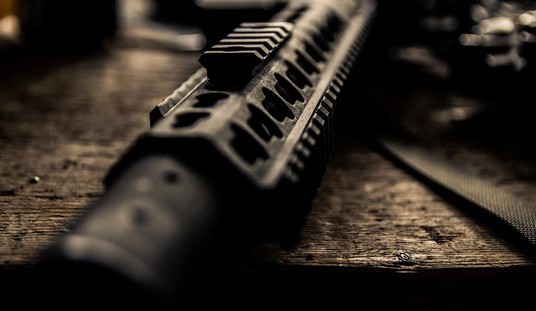
After many years of service, the Army is looking to replace the venerable Beretta M9 9mm handgun with something else:
The U.S. Army is moving forward to replace the Cold War-era M9 9mm pistol with a more powerful handgun that also meets the needs of the other services.
As the lead agent for small arms, the Army will hold an industry day July 29 to talk to gun makers about the joint, Modular Handgun System or MHS.
The MHS would replace the Army’s inventory of more than 200,000 outdated M9 pistols and several thousand M11 9mm pistols with one that has greater accuracy, lethality, reliability and durability, according to Daryl Easlick, a project officer with the Army’s Maneuver Center of Excellence at Fort Benning, Georgia.
“It’s a total system replacement — new gun, new ammo, new holster, everything,” Easlick said.
The Army began working with the small arms industry on MHS in early 2013, but the effort has been in the works for more than five years. If successful, it would result in the Defense Department buying more than 400,000 new pistols during a period of significant defense-spending reductions.
Army weapons officials maintain that combat troops need a more effective pistol and ammunition. But experts from the law-enforcement and competitive shooting worlds argue that tactical pistol ammunition — no matter the caliber — is incapable of stopping a determined adversary without multiple shots in most cases.
One of the major goals of the MHS effort is to adopt a pistol chambered for a more potent round than the current 9mm, weapons officials said. The U.S. military replaced the .45 caliber 1911 pistol with the M9 in 1985 and began using the 9mm NATO round at that time.
The article goes on to say that the competition will be an open-caliber competition… which is false.
The .357 SIG and .40 S&W are dead on arrival as military calibers.
The Army wants a handgun caliber that is durable and long-lasting, and which doesn’t beat guns to death prematurely. Law enforcement agencies are already abandoning both of these calibers because of continual frame and slide cracking issues. They are returning to 9mm (due to advances in ammunition performance with modern hollowpoints) and .45 (due to the general thought that “bigger is better” and advances in modern hollowpoint design).
As the military isn’t impressed with 9mm ball ammunition (due to the Hague Convention of 1899, Declaration III, expanding ammunition is illegal for international warfare in most circumstances), this means that .45ACP will once again reign as the Army’s handgun caliber, by default.
The only real question in the “caliber debate” is whether the Army will return to the old standard of 230-grain ball, or if they’re entertaining the notion of testing lighter, faster, 185-grain flat-nosed FMJ load.
You’ll also note that the competition is for the Modular Handgun System, which throws the majority of .45 ACP handgun manufacturers out of the competition right off the bat.
Colt, Glock, Heckler & Koch, Para-Ordnance, Remington, Smith & Wesson, Springfield Armory, etc do not have a truly modular handgun system.
Offhand, it appears that only the Sig Sauer P250 has a legitimately modular system in .45 ACP among major manufacturers…

…but it too, has a very significant hurdle to overcome.
You see, the P250 is yet another “plastic fantastic” with a polymer frame, and the U.S. military has never shown significant interest in purchasing polymer frame pistols for general issue. Presumably, their prior testing of polymer-frame firearms has convinced them that they lack certain characteristics that they desire, and there have been proven instances of “kabooms” happening with polymer framed firearms that are much less common in metal-frame firearms.
There are also ergonomic concerns that must factor into the adoption of any new pistol, of course, with more women joining the military, meaning that a pistol must fit a wider range of shooters than ever before.
In the end, the Army is looking for a metal-framed, modular, .45 ACP pistol that is capable of being fired accurately and controllably by the widest number of soldiers possible.
Only one handgun system comes close to meeting those criteria, and it already exists…
Meet the Detonics MTX/STX system.

On the surface and to a casual glance it looks like a fancy 1911, but the devil is in the details. Both the grip and the top end can be swapped out for different sizes and lengths roughly analogous with with full-size, commander, and officer length 1911s, but the differences are what set the pistol apart, starting with the design of the grip.
The pistol uses double-stack STI 2011 magazines (in 10/12/14 round configurations), and packs them into a grip narrower than a 1911 frame with the wooden grips attached, at an entirely different grip angle. Without going into the science of the design of the grip, it is obviously undercut both front and rear, and creates a much lower bore axis and much lower felt recoil. Shots fired from an MTX in .45 ACP feel more akin to shooting a soft 9mm, and the pistol comes back on target faster for follow up shots. The single-action design and relatively conventional 1911 style upper with a match-grade barrel and trigger lends the gun to very accurate shooting… and we’re not done with the modularity of the system.
The “S” in the STX part of the system stands for striker-fired, and holds several patents involving the grip and the striker system.

With a relatively simple parts swap, the MTX can be reconfigured from an advanced double-stack single-action .45 ACP pistol to an advanced double-stack striker-fired pistol that uses the same holsters and magazines.
There is, of course, a huge hurdle to adopting the MTX/STX by the Army, and that is the production capacity of Detonics Defense. The small company located in Milstadt, Illinois, is simply not capable of producing the 400,000 pistols that the Army wants, nor the additional pistols that will likely be requested by the Pentagon for the other services if the design proves to be a success. Detonics is going to have to partner with a larger domestic company experienced with producing large numbers of metal-framed handguns.
The number of companies with that capability can be counted on one hand.
Let the courting begin.
In the meantime, Detonics is selling the MTX to consumers… when they can keep them in stock.








Join the conversation as a VIP Member